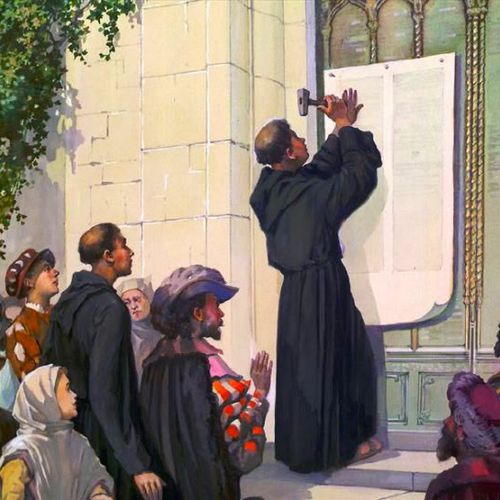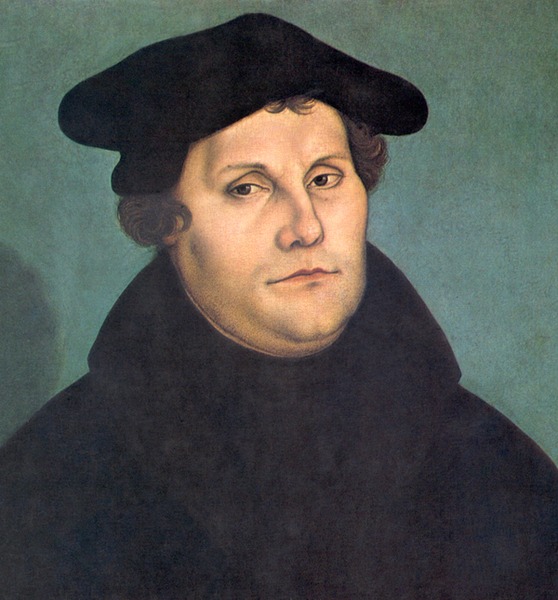Martin Luther began the Protestant Reformation in 1517 when he nailed his 95 Theses on the castle church door in Wittenberg, Germany. Luther was a controversial figure in his day, with great friends and foes during a period of tumult in the Roman Catholic Church.
Born in 1483, Luther was the son of a reasonably prosperous copper miner. An intelligent boy, he was sent away to school by his father, who hoped he would be a lawyer. That was not to be. At the end of his university studies at Erfurt in 1505, Luther was caught in a terrible thunderstorm, where he prayed to St. Anne for deliverance, vowing to become a monk. Soon after that, he made good on his promise and entered the Augustinian monastery in Erfurt.
The monastic life at that time varied greatly, depending on the monastery. The Augustinian monks were quite strict, with fasting and a rigorous schedule of prayer, study, and work. Luther was ordained a Catholic priest in 1507 and completed his doctoral studies in 1512.
  |
He then was assigned by his superior to teach biblical studies at the University of Wittenberg in Germany. Preparing his lectures on the Bible (especially the books of Romans and Galatians), he became increasingly dissatisfied with the current practice of the church compared to what he saw in the Bible. His lectures were quite popular among the students, and he drew together a circle of other professors around him for discussion.
In 1517, he decided to tackle the issue of the sale of indulgences (a document granting a person exemption from the penalty for his or her sins) by writing a document that contained 95 statements (or theses) that argued against the practice of the sale of indulgences.
Many knew that Prince Albert of Germany had arranged with Pope Leo X to turn over half of the proceeds from the sale of indulgences to the pope, who needed money to finish building St. Peter’s Basilica, and turning the rest over to bankers who had funded Prince Albert’s purchase of bishoprics. But it was the shameless manner in which the indulgences were sold that was too much for Luther.
Freedom from the penalty of even the gravest sins was promised by the Dominican monk Tetzel as he sold the indulgences in the neighboring areas. At that time, Luther did not imagine the storm of controversy that his few pages would cause. Because of the recently invented movable type printing press, within a few short months, Luther’s 95 Theses were printed and sent out all over western Europe.
 |
| Martin Luther and his theses |
The Catholic Church’s response was first to wait and see whether the controversy would die down. When it did not, Luther was approached by high-ranking church officials who asked him to retract or recant his statements. Finally in 1521, Luther was summoned before the emperor at the Diet of Worms.
There, with his books and pamphlets in front of him, he was asked to recant his writings. His response, considered apocryphal by some, “Unless I can be instructed and convinced with evidence from the Holy Scriptures or with open, clear and distinct grounds and reasoning ... then I cannot and will not recant, because it is neither safe nor wise to act against conscience. Here I stand. I can do no other. God help me! Amen.”
Luther knew that his statements would probably cause his expulsion (excommunication) from the Roman Catholic Church and that he would have to flee for his life. Fortunately for Luther, a sympathetic German prince, Frederick the Wise, “kidnapped” him and hid him in the Wartburg castle till the storm blew over.
   |
Because of the support of Frederick and other German princes, the “Lutheran” movement grew in strength over the next 10 years. Excommunicated from the Roman Catholic Church, Luther and his followers took over the churches in the areas in Germany that had sympathetic princes.
Luther continued to teach and write at the University of Wittenberg. He married a former nun, Katherina von Bora, in 1525 and had six children. Luther died in 1546. Luther wrote a great many books and shorter articles. (There are more than 100 volumes of his works.) These include Luther’s Small Catechism, Luther’s Large Catechism, The Bondage of the Will, and On the Freedom of a Christian. He also translated the Bible into German—prior to this time it was only available in Latin.
Luther was an outspoken man, tending to make outrageous statements, especially at the dinner table (e.g., “When I die I want to be a ghost and pester the bishops, priests, and godless monks so that they have more trouble with a dead Luther than they could have had before with a thousand living ones”).
Some controversy has arisen in more recent years about Luther’s statements in his later years against the Jews. These were not unusual for their time but are seen by Lutherans today as very unfortunate.
Many people try to simplify the Reformation as if Martin Luther appeared out of nowhere with a strident call for reform. This was not the case. There were many calls for reform and many attempts at it during the previous 100 years.
Luther was also heavily influenced by the humanists, especially Erasmus of Rotterdam, who were arguing for an intellectual reform, returning to the original Greek and Hebrew sources for both philosophical and Christian thought.
“Luther hatched the egg that Erasmus laid” is a common phrase describing the intellectual development of Luther. Luther was a somewhat reluctant, but certainly courageous leader and thinker during a time of great change in the church and society.
